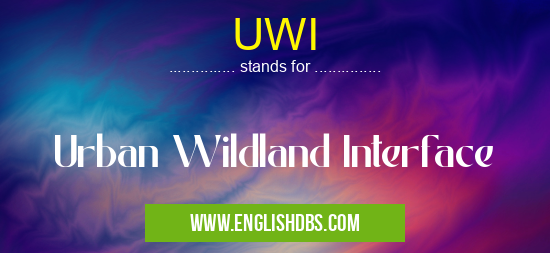What does UWI mean in UNCLASSIFIED
UWI stands for Urban Wildland Interface. It refers to the area where developed areas, such as residential neighborhoods, meet undeveloped open spaces, like forests or grasslands. This interface zone presents unique challenges and opportunities for land management and community planning.

UWI meaning in Unclassified in Miscellaneous
UWI mostly used in an acronym Unclassified in Category Miscellaneous that means Urban Wildland Interface
Shorthand: UWI,
Full Form: Urban Wildland Interface
For more information of "Urban Wildland Interface", see the section below.
UWI Meaning
In the context of land use and fire safety, UWI encapsulates the transition zone between urban and wildland areas. It includes both the developed and undeveloped lands that interact with each other. Key characteristics of UWI include:
- Proximity to Vegetation: Houses and other structures are built close to natural areas, increasing the potential for wildfire impacts.
- Fuel Accumulation: Wildland areas within the UWI may accumulate dry vegetation, providing fuel for wildfires.
- Human Activity: Residents and visitors engage in activities that can start or spread fires, such as campfires, fireworks, or arson.
- Fire Behavior: Wildfires can behave differently in UWI areas due to the complex mix of vegetation, topography, and human factors.
UWI Management
Managing UWI areas requires a collaborative effort involving residents, land managers, and emergency responders. Key strategies include:
- Fire Prevention: Educating residents about wildfire risks and promoting fire-safe practices.
- Fuel Management: Removing or reducing flammable vegetation near homes and clearing dead or overgrown vegetation.
- Building Codes: Enforcing building codes that require fire-resistant materials and defensible space around structures.
- Emergency Planning: Developing evacuation plans and coordinating with fire departments for quick response and suppression efforts.
Essential Questions and Answers on Urban Wildland Interface in "MISCELLANEOUS»UNFILED"
What is the Urban Wildland Interface (UWI)?
The Urban Wildland Interface (UWI) refers to the areas where human development meets undeveloped natural landscapes, such as forests, grasslands, and shrublands. These areas are characterized by a high risk of wildfire due to the proximity of flammable vegetation to human structures.
Why is the UWI important?
The UWI is important because it presents a significant fire hazard to human populations and property. Wildfires originating in natural areas can spread rapidly into populated areas, causing extensive damage and loss of life. The UWI also affects air quality, water quality, and the health of ecosystems.
What are the key factors that contribute to wildfire risk in the UWI?
Key factors that contribute to wildfire risk in the UWI include:
- Fuel availability: The presence of dry vegetation, such as grasses, shrubs, and trees, provides fuel for wildfires.
- Fire weather: Dry, hot, and windy conditions increase the likelihood of wildfire ignition and spread.
- Topography: Steep slopes and narrow canyons can create hazardous conditions for firefighting and evacuation.
- Human activities: Human activities, such as smoking, campfires, and fireworks, can accidentally ignite wildfires.
What are the consequences of wildfire in the UWI?
Wildfire in the UWI can have devastating consequences, including:
- Loss of life and property
- Damage to infrastructure and natural resources
- Disruption of essential services
- Air pollution and health impacts
- Economic losses
How can wildfire risk be reduced in the UWI?
Strategies to reduce wildfire risk in the UWI include:
- Creating defensible space around homes and structures: This involves clearing flammable vegetation and creating a buffer zone between buildings and potential fuel sources.
- Implementing prescribed burns: Controlled burns can reduce the buildup of dry vegetation and mitigate wildfire risk.
- Managing forests and vegetation: Thinning forests and removing dead or diseased trees can reduce fuel availability.
- Enforcing fire prevention regulations: Restrictions on smoking, campfires, and fireworks can help prevent accidental ignitions.
- Educating the public about wildfire safety: Raising awareness about wildfire risks and prevention measures is crucial for reducing the likelihood of human-caused fires.
Final Words: UWI plays a crucial role in land use planning and wildfire management. By addressing the unique challenges and opportunities of this interface zone, communities can mitigate wildfire risks, protect property and lives, and preserve the delicate balance between urban and wildland ecosystems.
